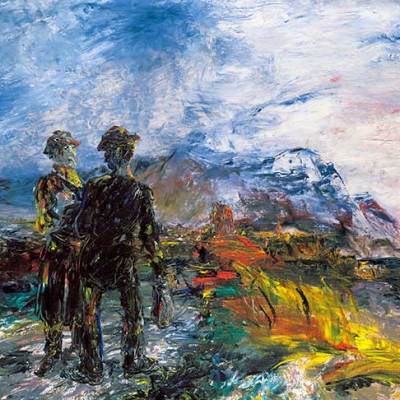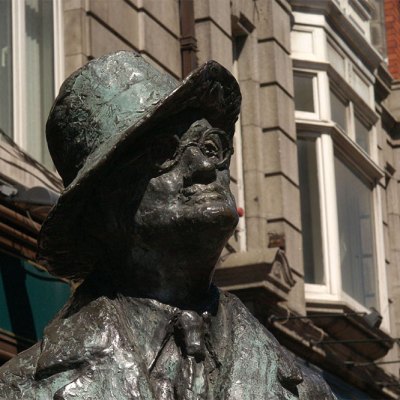From the October 2021 issue of Apollo. Preview and subscribe here.
By the early 1900s, Dublin had one of the most extensive tram systems in the world. From Blessington in the Wicklow Mountains to Lucan up the River Liffey, from Howth on the north side of the bay to Dalkey on the south, the city could be traversed. Rural Ireland had an extensive train network too. In the wilds of West Cork, Bantry, Schull, Baltimore, Skibbereen, Clonakilty, Kinsale and many places in between were all at one time interconnected. What now seems like a hopelessly utopian future is actually a thing of the past.
‘Jack B. Yeats: Painting and Memory’ at the National Gallery of Ireland marks the 150th anniversary of the artist’s birth. It is the largest exhibition of Yeats’s oil paintings in 50 years, bringing together 84 pictures. Several feature trains and trams. Irish painting more generally has a curious relationship with these modes of transport. In 1925, Paul Henry produced the first in a series of travel posters for the London Midland and Scottish Railway Company. They romanticised and commodified the Irish landscape by depicting it as being largely devoid of people. The only signs of life are an occasional whitewashed thatched cottage in the foreground. There is no train in sight. With Yeats’s paintings, by contrast, we see the train or tram. Or rather, as with Looking Forward, Looking Back (1945), we are often placed inside these vehicles, alongside the other passengers. In a carriage sit two figures either side of a table, one looking up, the other down. They are distinct yet barely distinguishable from their darkened surroundings. The window beyond frames a luminous landscape, momentarily stilled yet being passed. Looking out from within, we are disconcertingly placed amid an intangible sense of time and space.
Looking Forward, Looking Back (1945), Jack B. Yeats. Private collection. Photo: Prudence Cuming; © Estate of Jack B. Yeats, DACS London, IVARO Dublin, 2021

Yet Yeats is no straightforward recorder of the impressions of modernity. His career and working practices developed in unusual ways. He had no conventional training in oils, but began working as a commercial illustrator in London in the late 1880s, and established himself in the art world as a watercolourist a decade later. It was not until his late thirties that he took up oil painting regularly. He produced more than half of his canvases (out of some 1,200) in his seventies and eighties, during the last 15 years of his life. Painted in the studio, these drew on his memories and the sketchbooks of his youth to create an enigmatic pictorial language, offered through an increasingly fearless exploration of the expressive possibilities of line, colour and texture.
Decidedly taciturn, Yeats was famously wary of talking about his paintings. His titles range from the baldly descriptive, such as Looking Down on the Old Racecourse of Bowmore, Sligo (1944), to the literary and the lyrical, as with And So My Brother Hail and Farewell for Ever More (1945) – a translation of the final line of Catullus’s elegy to his dead brother’s ‘mute ashes’. The curators’ thematic groupings provide further footholds: ‘Place’, ‘Characters’, ‘Fleeting Moments’, ‘The Epic in the Everyday’, ‘Recollections and Reimaginings’. These give a sense of how Yeats’s work is at once grounded in actual places and people, yet highly imaginative and metaphysical.
Bachelor’s Walk, In Memory (1915), Jack. B. Yeats. Photo: National Gallery of Ireland

Key to this apparent paradox is Yeats’s limpid brushwork. The exhibition contains a handful of paintings from the 1910s, including Bachelor’s Walk, In Memory (1915) and Double Jockey Act (1916). The first is a justly famous political painting, a direct response to the British army’s killing of four civilians on a Dublin street after the Irish Volunteers landed guns at Howth. Double Jockey Act comes out of Yeats’s interest in the theatrical characters he had sketched at rural Ireland’s travelling circuses and fairs. In neither has Yeats quite yet transferred his mastery of the drawn line to paint. Around 1920, there is some kind of leap forward. In Approaching Rosses Point, Early Morning (1920) and The Dawn, Holyhead (1920), for instance, the palette is still relatively muted, the composition distinctly realist. Yet the painting, especially in its modelling of the human figure, is on its way to becoming all line.
Yeats’s palette went on to be notably multicoloured. Just as striking, however, is his distinctive use of white and black. In the exquisite small painting A Morning (1936), bought in instalments by a young Samuel Beckett, a preponderance of white seems to affirm the whole scene as blessedly insubstantial. The black clothed figures merging into a black cityscape in Dublin, Number One Ferry – Dinner Hour (1927), meanwhile, seem to offer, without judgement or regret, the living as coterminous with the dead. Here, as elsewhere, Yeats manages to pull off the trick of rendering the human face as curiously featureless yet still decidedly present. Open, often singing mouths are also a recurrent motif: the titles of five paintings in the exhibition are ‘Singing’ followed by the title of a song. Out of a near void gapes a mouth in Singing ‘Rolling Home’ (1946), the song trapped within the still moment of the image.
A Morning (1936), Jack B. Yeats. National Gallery of Ireland, Dublin. Photo © National Gallery of Ireland; © Estate of Jack B. Yeats, DACS London, IVARO Dublin, 2021

By the 1940s and ’50s, another characteristic effect is the rendering of his figures in vigorous impasto, but set against a barely started background, the canvas unprimed, the oil paint streaks seemingly a mere wash. In Roadsters Old and Young (1955) one kind of sketchiness is played off against another. A pair of presences are registered at an unbridgeable remove from the landscape through which they are wandering. This painting usually hangs in the Art Institute of Chicago. Many others collected in the exhibition are in private hands. These include the large, late masterpiece The Basin in which Pilate Washed his Hands (1951), which dominates the exhibition’s final room. A beguilingly mysterious and complexly textured work, it is a painting, like so many by Yeats, that really needs to be seen in the flesh. Catch it while you can. Why not take the train?
‘Jack B. Yeats: Painting and Memory’ is at the National Gallery of Ireland, Dublin, from 4 September–6 February 2022.
From the October 2021 issue of Apollo. Preview and subscribe here.



